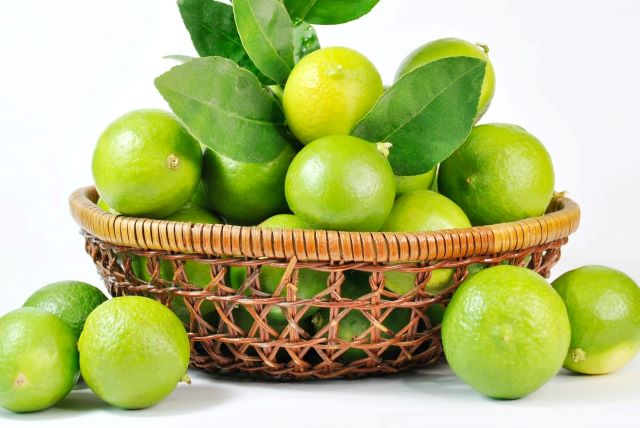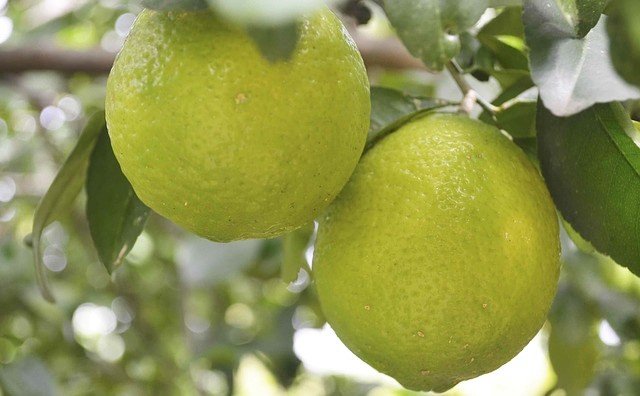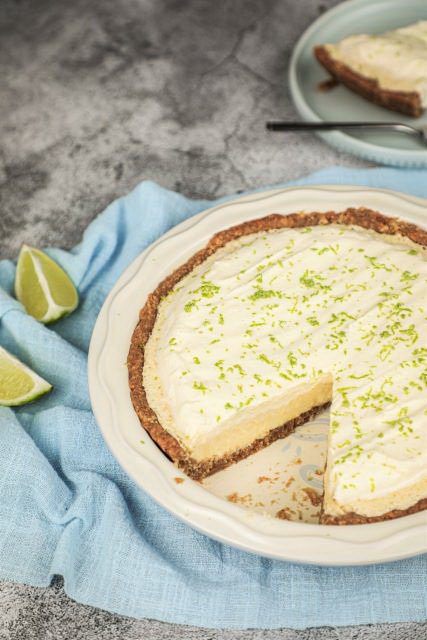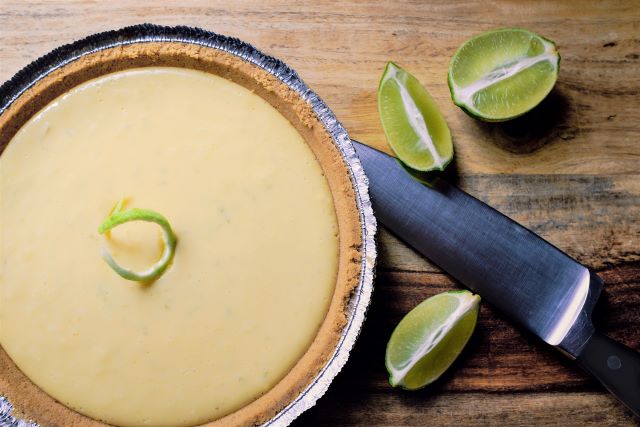Key limes are an incredibly versatile fruit and having a key lime tree in your backyard opens you up to a ton of yummy benefits. From cocktails to tacos, key limes are the perfect addition for that bite of tart. Our favorite recipe, though, is a delicious key lime pie. If you’re interested in the sweet and tangy treat, keep reading and you’ll learn how you can grow your very own key lime tree to make key lime pie.
Table of Contents
What are Key Limes

Key limes are the fruit of a citrus hybrid tree and are often referred to as West Indian, Mexican lime, or more colloquially, the Bartender’s lime. They’re much smaller than the fruit we typically associate with the word lime (the Persian lime) and can grow to the size of a large walnut or golf ball at their peak (1-2 inches or 2.5-5cm).
Key limes are one of the most common type of lime across the globe and are favored for their higher acidity, potent aromatic scent, thin skin, and juiciness.
The “Key” in key lime originated due to its presence in the Florida Keys, a series of islands off the coast of the tropical state, but the fruit itself didn’t start there.
Though native to Southeast Asia, with the help of Arabian and Spanish traders, it tracked its way from the Middle East, through Northern Africa, and into the Caribbean until it found its way to Florida where it picked up the moniker.
The key lime had a short but prosperous start there until a natural disaster wiped out most of the groves and was consequently replaced with the lime that is most familiar to the United States today.
The Persian Lime was more appealing as they were larger and didn’t contain any seeds, unlike the key lime.
While it is possible to replace the key lime with the Persian lime, the difference in taste is slightly noticeable. Persian limes tend to be more tart, as ripened key limes sweeten a bit more than their cousin, making them perfect for the baked treat.
If you want the authentic key lime pie taste, growing your own trees is a great place to start.
Ideal Growing Conditions for Key Lime Trees
Climate for Key Limes
Whether you should grow your key lime tree outside or within a temperature-controlled environment depends entirely on your climate. Key lime trees thrive in consistent warm or tropical environments, so you don’t want to go digging up the soil in your backyard if you live somewhere where your winters grow too cold for the delicate tree to survive.
If you live in North America, you can check your climate’s compatibility using the USDA Hardiness Zone Map. The map separates the continent into eleven planting zones, grouping them together by temperature. If you live in zones 9-11, you’re in luck. Your key lime tree will survive outdoors.
If you live outside of North America, look into similar zone maps or climate information for your region. A great rule of thumb is to make sure at no point do your temperatures drop below 32°F (0°C), as this will expose the plant to injury, and it will start shedding its leaves. Below 28°F (-2°C), the plant will begin to die.
If your winters are typically temperate enough to grow your citrus fruits outdoors but a cold spell comes through, you’ll need to either move your plant indoors. If you chose to plant it in a container, which is optimal if your climate isn’t warm year-round, or shelter it with an anti-frost, insulated blanket or cover to protect it from frost damage.
You’ll want to pick any fruit that has already grown on the tree, as freezing temperatures can affect the taste.
Sun Requirements for Key Lime Trees
Your key lime tree is going to need a lot of sun. The ideal location is somewhere the tree can get upwards of 8 hours of sunlight daily. The more sun you can provide lime trees, the better. The exposure to heat is what makes a particularly delicious lime.
In order to pick the best location, you’ll want to monitor your yard throughout the day before choosing the perfect spot.
Check the shade and sunlight positions periodically throughout the day. You can do this simply by observing where the light hits.
Or you can create your own sun exposure chart and keep track of whether your desired location receives full sun, full shade, or partial exposure throughout the day.
The place that receives the most sun is where you should plant your key lime tree if you want the highest quality of fruit.
Soil for Key Lime Trees
Fertile sandy loam soil is often recommended for citrus trees. The ideal soil pH should be between 6-7.5 (you can check this with a soil monitor here).
You’ll want to make sure the soil you choose has excellent drainage. Key limes require a lot of watering and because the roots of a key lime tree grow shallow, they will rot if left in consistently soaked soil.
Soil can be prepared prior to planting with compost and aged manure. It’s ideal if the soil can be prepared a few weeks prior to planting to allow the compost and manure to partially break down and increase the soil fertility.
For less than ideal soil conditions, consider creating a gentle mound to plant into. The mound can be built up with compost, aged manure and soil, which will help drainage.
Watering Key Lime Trees
A good rule of thumb for watering your key lime tree is to water it once or twice a week and water them deeply. At least until six inches of the soil is soaked or until water starts draining out of the potting container.
Water again once the top of your soil completely dries out.
How often you water and the amount of water you provide your key lime tree depends on your climate. If you’re in a hotter climate, you’ll want to water more frequently as the sun can dry up the water quicker than the roots can absorb them.
Even though your key lime tree needs a good amount of water, it is possible to overwater them.
If the leaves begin to turn yellow or curl up, you might be giving them too much water. If this is the case, reduce watering and monitor your key lime and adjust watering as necessary.
Fertilizer for Key Lime Trees
Citrus trees, including key limes, are heavy feeders, which means they consume large amounts of nutrients from the soil. To balance this, you’ll need a good fertilizer.
A good fertilizer will have a 2-1-1 ratio of nitrogen, phosphorous, and potassium. Look for beneficial minerals such as iron and zinc.
Avoid mixing your fertilizer with the soil as that can cause the roots to burn. Rather, choose a slow-release fertilizer and spread it across the top of your soil before watering such as this organic citrus fertilizer here.
The addition of aged manure and compost is also beneficial for between fertilizing.
Generally, citrus requires fertilizing 3-4 times a year. So it’s a good idea to remember to fertilize your key lime at the start of each season. Depending on your climate, fertilizing during winter may not be necessary.
Planting a Key Lime Tree

If you choose to plant your key lime tree in a pot or container, you’ll want to choose a pot with a wide diameter. Key lime tree’s roots grow shallow which means they’ll be more spread out than your average fruit tree. Choose a pot with a diameter of 28 inches (71cm) or larger in order to accommodate this.
If you choose to plant your key lime tree in the ground, you’ll want to dig a hole double the width of the root ball and just as deep. Before setting the key lime tree into the ground, be sure to give the immediate area a good weed. If weeds are left to grow around a young key lime tree, there’s a chance they will suffocate the tree, so it’s best to get rid of them.
Planting is best in early spring if you live in colder climates. If you live in a warm environment, you can plant your tree anytime throughout the year.
How Big do Key Lime Trees Grow?
Growing key limes in a pot will mean they can be kept small to 6 feet (1.8 meters). Grown in the ground, key lime trees can grow 6-12 feet (1.8-3.6 meters).
How Long Does it Take for Key Lime Trees to Fruit?
Flowering typically happens when your key lime tree is 2-3 years and fruit begins to ripen after five or six months after flowering.
By purchasing a larger, more mature tree, you may even have key limes in the first year of planting.
When are Key Limes Ripe?
You’ll know a key lime is fully ripened when it turns yellow, but it’s recommended to pick them before then. Limes are typically picked while green, which is the color you’ll see them within the store, and they’ll turn a lighter green to yellow when ripe.
Remember, key limes are the smaller cousin to Persian limes and won’t grow much larger than a golf ball. Waiting for them to grow larger can cause them to ripen past their most delicious stage.
Key limes are ready to eat when their green exterior begins showing yellow patches and gives in slightly when you press them. This is the best time to eat them as the yellowing patches indicate the reduction of the acid content within the fruit, which means you’ll end up with a sweeter lime and a tastier pie.
Key Lime Pie Recipes to Make

Of course, once you have grown your harvest of key limes, you are going to want to make the best Key Lime Pie possible.
Typically, Key Lime Pie is made with a filling of key lime juice, sweetened condensed milk, and egg yolks. Pies can be baked in a pie crust, graham cracker pie crust, and sometimes no crust at all. Key Lime Pie is often finished with a topping of cream, meringue or no topping.
Our recipe for key lime pie is a gluten free version with an almond crust. We’ve also used whole eggs as opposed to just yolks. The recipe is here: Easy Gluten Free Key Lime Pie Recipe with Almond Crust.
For some more ideas, here is a selection of other delicious key lime pie recipes you can try.
Classic Key Lime Pie from Live Well Bake Often
Key Lime Pie from Martha Stewart
7 Ingredient Vegan Key Lime Pie from the Minimalist Baker
Key Lime Pie from the Preppy Kitchen
Our Favortie Key Lime Pie from Epicurious

Conclusion
Key lime trees are delicate and sensitive trees but taking the time to grow them with the utmost care is immensely rewarding. Before you know it, you’ll have all the key limes you could want are your disposal to bake in the most delectable treats. That first bite into a homemade key lime pie, and you’ll be wondering why you didn’t try this sooner.
Recommended Products
Some Favorite Gardening Products
- AeroGarden Bounty Indoor Hydroponic Herb Garden
- King Bird Raised Garden Bed
- Felco Garden Pruners
- Sloggers Waterproof Garden Gum Boots
Further Reading:
- Easy Gluten Free Key Lime Pie Recipe with Almond Crust
- How To Make Lemon And Lime Cordial: Homemade Cordial Recipe
- Raspberry and Lime No-Churn Ice Cream Recipe
- How to Grow Kumquats: Complete Guide To Kumquat Tree Care
- How To Grow A Lemon Tree With Prolific Fruit At Home
- Citrus Leaf Miner Control: Natural And Organic Methods
- Tree Tomato: How to Grow Tamarillo Trees and Eat The Fruit
- Kaffir Lime Fruit Uses In The Kitchen And Home
- Why Is My Lime Tree Dying? Causes and Solutions
- Why Is My Lemon Bitter? Answered!

